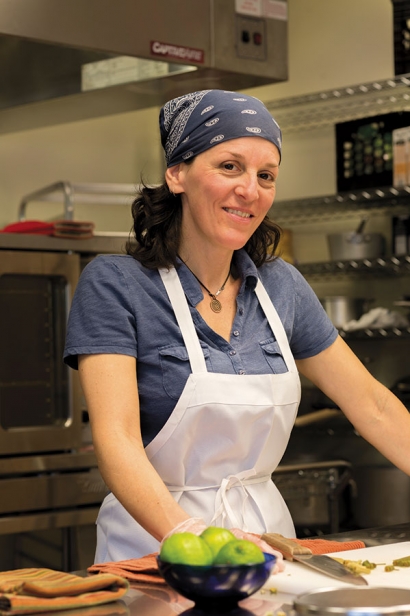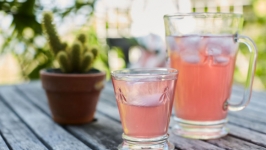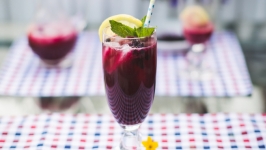Hedonic Tonic
Clinking cocktail glasses brimming with gin and tonic and drinking to your companion’s health is an exercise in superstitious silliness, best executed with bemused irony and a single, cocked eyebrow.
’Twasn’t always thus.
In the 1600s, Spanish explorers in Peru learned that indigenous people used bark from cinchona trees to effectively treat their fevers and fight malaria. Missionaries dubbed it Jesuit’s bark and brought it back to Europe, where its use spread. Most modern tonic enthusiasts are familiar with cinchona in the form of quinine, the amine first isolated and extracted from the bark in 1820.
In the early 1800s, a brilliant (tragically anonymous) individual thought to temper the bark’s bitter taste by mixing it with bubbly water, sugar and, famously, gin, giving rise to one of the most beloved cocktails in history: the Gin and Tonic. Soon, colonialists everywhere were saying “cheerio” to malaria in a fantastically delicious way. Tonic water was first marketed commercially on its own in 1858.
In recent history, the tonic water market has been dominated by large corporate behemoths that eschew the traditional sugar, citrus and botanicals for high-fructose corn syrup, citric acid and sodium benzoate, among other equally dubious “natural flavors.” Nothing can ruin a perfectly complex natural botanical bouquet more than lashings of synthetic additives, but until you get ahold of the real stuff, you don’t know what you’re missing.
Luckily, for nominally health-conscious (and definitely discerning) cocktail enthusiasts, a cottage industry of local tonic water producers has emerged in the past decade. Edible recently caught up with Jill Malouf of Hedonic Tonic, who has gone even further than the average bespoke quinine crafter, by producing a tonic syrup that is as delicious as it is wholesome.
“I created my own tonic syrup because I didn’t like what was on the market,” Jill explains. “I was working on a film project at the Kentucky Derby in 2013, and the crew went out for a drink afterward at this fantastic bar that made its own tonic syrup. I realized what I’d been missing and knew I could never go back.”
She was intrigued by the complex taste, the brown color (cinchona bark is brown) and the manner in which it complemented and transformed the gin.
When Jill got back to Albany, she began experimenting with recipes for tonic syrup. After perfecting her recipe and stocking her home bar, friends and colleagues got a taste of her magical elixir. They began clamoring for more, more, more, so much so that she was prompted to launch an official line in 2014.
“Fresh, local, sustainable food products have always been a passion of mine,” Jill says. “I began volunteering at Nine Mile Farm, a farm following organic standards outside of Delmar, because I was making some changes in my personal life and I felt I really had to get back in touch with the earth, with gardening, food and soil. I got to know the farmer, Rebekah Rice. Now I use her lemongrass in my recipe. I’ve experimented with using water from different places, and I have found that the tap water in East Greenbush is excellent because it’s such a pure flavor, free of minerals that can interact with my other ingredients and unbalance them.”
While Jill doesn’t have formal culinary training, her palate is clearly more refined and sensitive than most. In addition to utilizing the best tap water around and local lemongrass, Jill uses organic limes and unrefined sugar. Also, of course, cinchona bark. The unrefined sugar and cinchona bark combine to lend her syrup an amber hue, which at first feels slightly bizarre in a classic G&T. Quickly though, the sharp, deep, wonderfully complex flavors of Hedonic Tonic hypnotize, and before you know it, you’re dreaming of other uses for the tawny brew.
“I’ve worked in lm here since 1993 and it is an amazingly supportive, creative community,” Jill says, explaining that she generally splits her time between film work and tonic-making, and that each endeavor inspires and feeds the other. Her experience shooting and editing film has informed her ability to create, launch and manage a successful small-batch brand in a world in which media savvy and an instinct for visual depth are a requirement, even for an artisanal beverage.
But there’s more to it. Jill has a finger on the pulse of the district. In addition to working basically two full-time jobs and co-parenting her 10-year-old daughter with her ex-partner, she still volunteers at Nine Mile Farm, works on film projects for regional charities (“I’ll work with pretty much any free-thinking organization that needs a hand”) and volunteers time at the Sanctuary
for Independent Media in Troy. She is clearly the type of person whose genuine openness, kindness and creative spunk inspires reciprocal behavior in others.
Take her kitchen space, which just happens to be in her daughter’s private school. “Someone at my daughter’s school actually suggested I use their professional kitchen space for my brand when I was start- ing to get serious about launching,” Jill remembers. “We bartered an arrangement, so I do photo and lm work for them, and I have access to their amazing professional kitchen.”
Jill’s creative entrepreneurism is paying off. Hedonic is currently available at BREW Craft Beverage, Honest Weight Coop, Albany Distilling Company, New World Bistro Bar, Swoon Kitchenbar and several other outlets that support talented local artisans.
Don’t dig gin? No worries. “My daughter drizzles it on vanilla ice cream,” Jill says.
Customers have used it to marinate meats, veggies and fish. It’s delicious as an added zing in both salad dressing and plain old seltzer water.
Despite her success, Jill is thirsty for more. “I’m working on recipes for my next syrup. I think there may be a serious citrus element, and I’m definitely going to make sure that it can be paired with a variety of other beverages, both alcoholic and not.”
Intriguing. Can’t wait to taste more.










